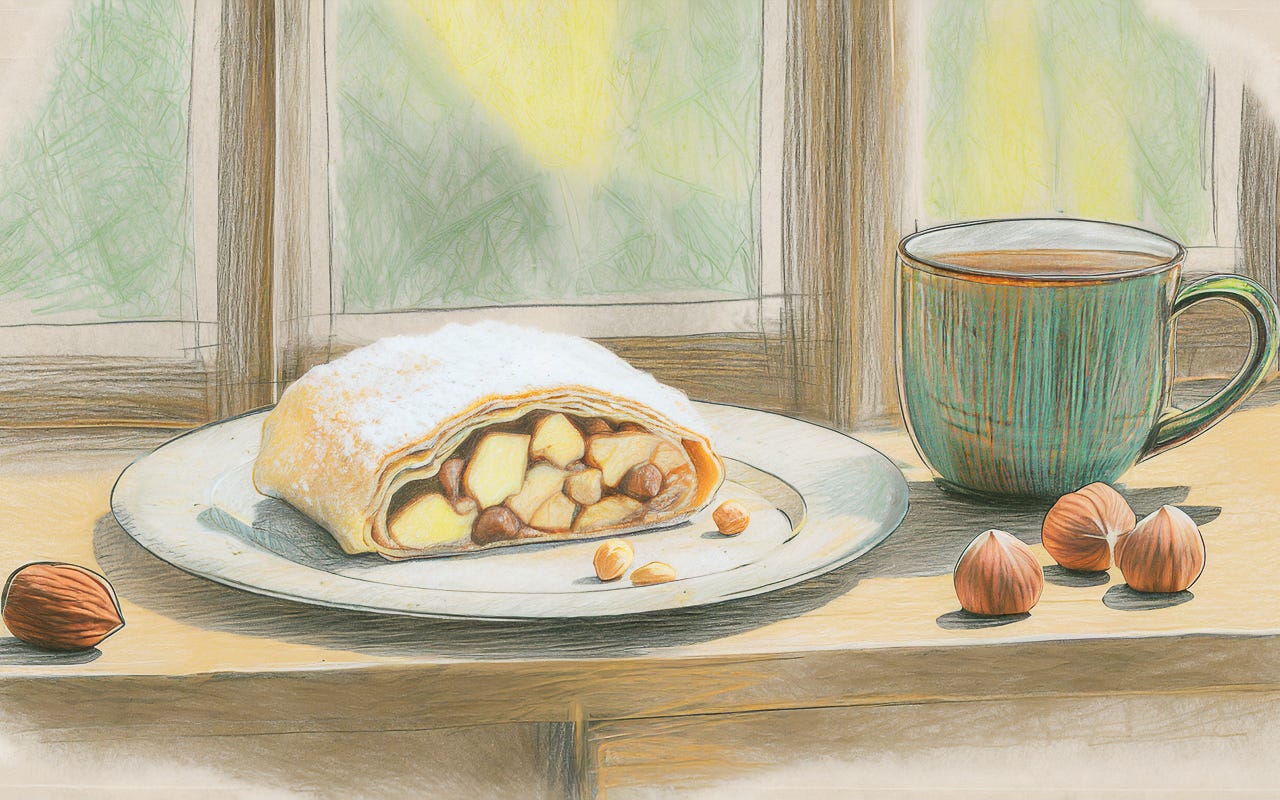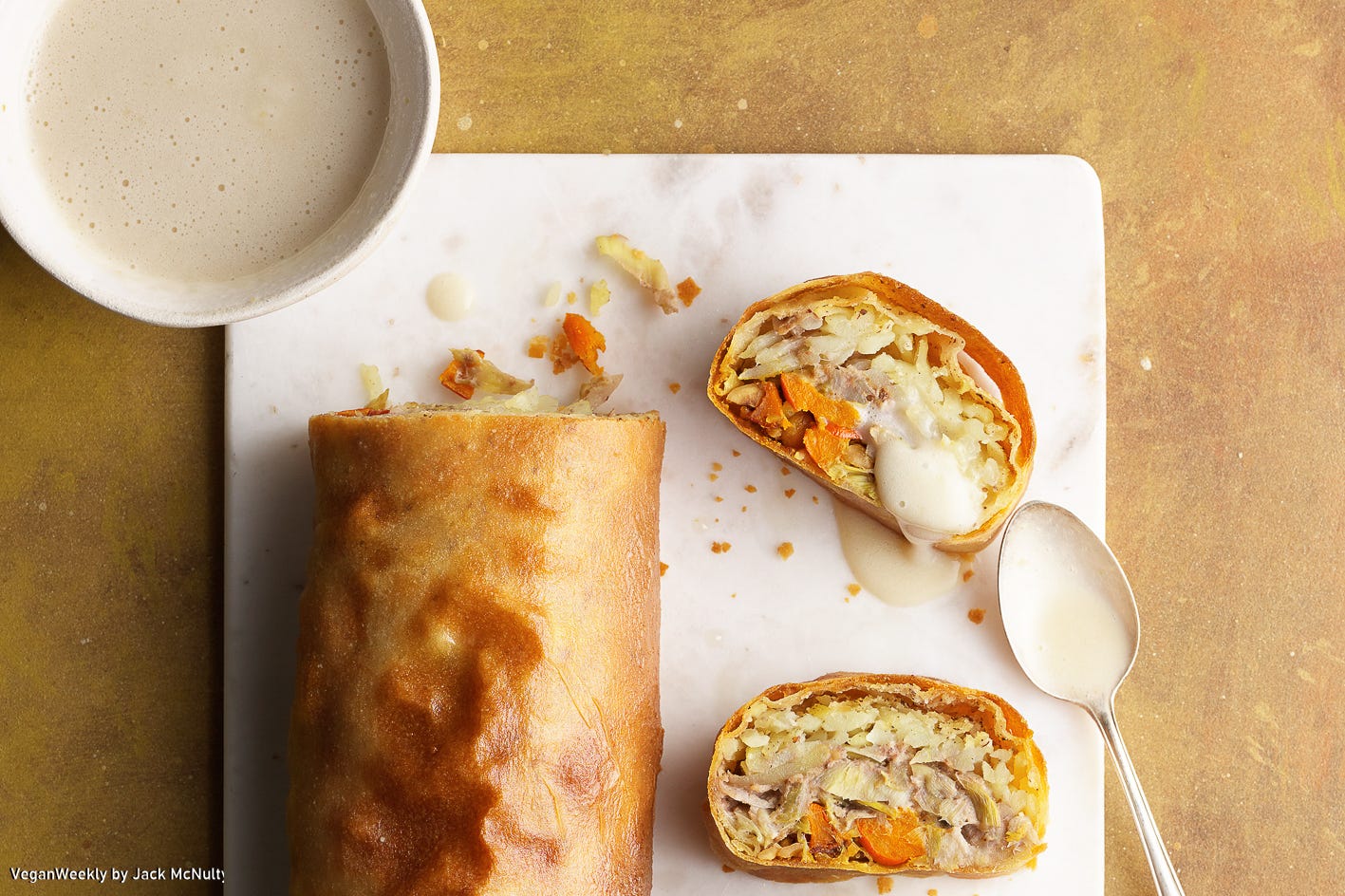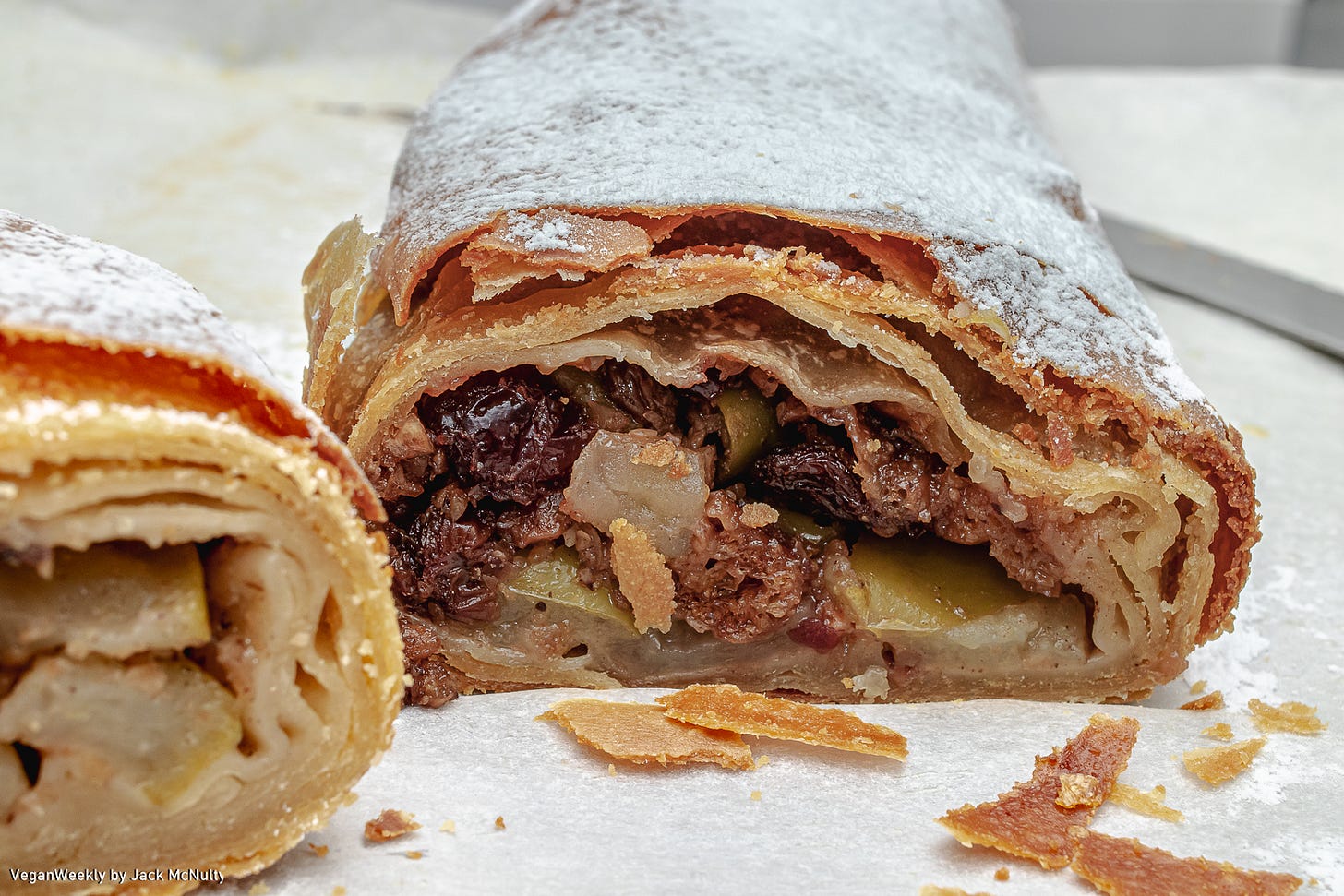Strudels, Strudels, Strudels
Getting over the strudel dough hurdle is easier than you may think, and that opens up a world of new plant-based ideas to explore.
Strudels sound exotic. It transports me to a fancy Viennese coffee shop, dressed in 1980s Euro-Urban-Hipster clothes, sipping a coffee (definitely a dark Viennese blend) while casually munching on a slice of apple strudel bathed in vanilla custard.
I want to make a strudel and go to that imaginary place. But there’s a hurdle to get over: the strudel dough. I doubt it stretches out as effortlessly as those TikTok videos demonstrate.
It seems unimaginable to take a piece of dough roughly the size of a normal hand and stretch it until it is paper-thin...something as thin as manufactured phyllo dough.
More importantly, why would anyone embark on such a culinary adventure when a version of the dough probably exists on the supermarket shelf just down the street?
Nevertheless, kitchen adventure seekers exist, and making strudel dough is a distant siren calling them to this imaginary Viennese Kaffeehaus. They must make this dough in the most traditional manner while filming every step and considering how cool and impressive this will look on their chosen social media platform.
I’m happy these adventure seekers exist; they stimulate curiosity and keep traditions alive. I’m also glad I’m more reserved in seeking out too many challenging culinary adventures - some call this more realistic and practical...and I’m okay with that label!
Still, making my strudel dough feels like an itch in the center of my mind that I can’t quite reach, although I know I must find a way, even if I accomplish the same goal using non-traditional methods.
Breaking Down the Strudel Dough Mystic
There are so many pitfalls in what should be a project that requires the same skill set as rolling out pasta sheets. But with strudel dough, some holes and tears can spring up at any moment. The dough can stick to the surface...or the towel if the instructions aren’t carefully followed. And there’s the whole shaping bit and the endless attempts at achieving a shape closely resembling a rectangle.
Yes, Yes, Yes. Crafting a pliable, resilient strudel dough that easily transforms into a large, paper-thin rectangular wrapper feels intimidating...but in reality, it’s much more achievable than most realize.
Let me break it down and reveal my chosen path of least resistance.
A strudel is essentially pasta dough that encases a filling and is baked to create a delightful, crispy, and flaky exterior. There’s nothing tremendously threatening or mysterious about that.
The foundation of an excellent strudel dough lies in the flour - it must possess sufficient gluten to turn into a robust, elastic dough (apologies to all GF followers). The structure of the dough (that gluten thing) is strengthened by adding a small amount of salt, using wheat flour with 13-14% protein levels, and kneading the dough persistently and aggressively. There’s nothing tremendously threatening or mysterious about that.
The elasticity and softness of the dough are enhanced by adding a small amount of vinegar and fat, using hot water in the mix, and kneading the dough persistently and aggressively (I know I mentioned that already, but it bears repeating). There’s nothing tremendously threatening or mysterious about that, either.
Mixing and kneading strudel dough is simple but takes longer to form than most dough. Allow at least 30 minutes to mix and knead the dough and at least an hour to rest it before attempting to form the strudel shape. The extended kneading and resting yields a soft, elastic, and surprisingly easy-to-stretch dough. I prefer mixing and kneading the dough by hand but remember, there are no rules, and using a mixer to make the dough is entirely okay. There’s still nothing tremendously threatening or mysterious about this.
First, it might be appropriate to remind readers (and myself) what the goal of a strudel dough is - to create a dough that can be thinly stretched so it can wrap around a filling several times. Okay...but how do I do that? Start by forgetting about stretching it out with your hands - you are not working in a bakery...and there is no reason to make a strudel larger than your baking pan or oven. Well-made strudel dough should be soft and stretchy after an hour of resting. It will be simple to flatten with your hands and gently shape it into a book-sized rectangle. Next, grab a rolling pin and roll out the dough - it easily and effortlessly becomes thinner and thinner as you roll from the center toward each corner. Work quickly, and don’t forget to occasionally lift and rotate the dough to prevent it from sticking on the towel (tip: the towel isn’t larger than the baking pan). There’s nothing mysterious about this...but it sounds mildly challenging, which seems much more achievable than stretching the dough on a sheet placed on your kitchen table to produce a strudel twice the size of your oven.
Job done...the rolled-out strudel dough is still thin enough to see the pattern on your kitchen towel - or even to read printed text through the dough. It may not be as thin as phyllo dough...or an expertly stretched strudel...but thin enough - and that’s okay with me.
At this point, the total amount of time invested is roughly 35 minutes of active work and 60+ minutes of doing nothing except watching the strudel dough rest. There’s nothing tremendously threatening or mysterious about that.
Most of the work is done once the strudel dough is rolled out.
The dough needs a light coating of fat - in my vegan world, I elect to use unprocessed rapeseed oil mixed with a small amount of soy milk and a suggestion of baking powder. My oil mix replaces the traditional use of butter customary in most strudel-producing lands. The oil mix creates a crispier, albeit less flaky, exterior than those made with butter...but I’ve grown to prefer the crispier variation - it’s much more fun to eat.
Next comes a light coating of chopped nuts or breadcrumbs that soak up any bits of juice from the filling. This is essential in most strudels to prevent soggy dough or splits from the steam looking for an escape route.
Strudel fillings include anything that makes sense. On the sweet side, the traditional ingredients are apples, raisins, and spices. But you may also want to consider other seasonal fruits (pears and figs are excellent), dried fruits (I especially like tangy dried cranberries), and warm spices (I enjoy a hit of clove and freshly ground nutmeg - they create a pleasing holiday vibe). Savory traditions include potatoes, cabbage, onions, paprika, and caraway seeds. Again, there are endless options to consider in making a variation of your own. I like using sauerkraut, mushrooms, leeks, and pumpkin.
Strudel fillings should not have too much liquid. Squeeze out any remaining moisture in wilted greens or cabbage. Use breadcrumbs or croutons to absorb unwanted liquid...or even starches or a thick béchamel to coat the filling ingredients.
When baking the strudel, use moderate temperatures of 180° C (350° F). Bake the strudel until golden and crispy - usually 40-60 minutes, depending on the size. For vegan strudel, it’s a good idea to flip and baste it every 15 minutes to promote even baking.
As far as I can determine, the only requirements for making strudel at home are using exact measurements of the ingredients, having enough patience to methodically knead and rest the dough (this is also excellent therapy when stressed), ditching the stretching idea and using a rolling pin to create a thin rectangle, and avoid overthinking the process...it’s a simple recipe...you can do it...and none of it is threatening or mysterious.
A World of New Plant-Based Food to Explore
As you can see, making strudel at home is not mysterious or even that challenging. Getting the dough right is, of course, one key. But there’s always the option to use something store-bought when energy levels are low and time is at a premium. It may not be the same...but it will be good, as with most strudels.
Strudels live happily in a sweet or savory world, which means the filling is as open as your imagination. Traditional preparations and combinations are a great place to begin, but don’t feel tied down to these ideas - if you want to make a roasted parsnip and apple strudel, I promise I won’t stand in your way.
Because strudels adapt well to many ingredients, they are generally cost-effective to produce. Think of them as a hand pie that turns something modest into something much more interesting...even extraordinary.
Maybe...just maybe, strudels will turn into the next trend food. And why not? Trends tend to embrace foods that are widely familiar, quickly produced, inexpensive, and versatile enough to cover many dietary considerations. Strudels tick each of these boxes.
This Week’s Recipes…
Anyone can look at the index of my published recipes, but the links are restricted to those who support my work through a paid subscription. Please consider subscribing or updating your current subscription…or contact me if you want to organize a free trial.
Strudel Dough
Making a pliable, strong strudel dough that is elastic enough to roll or stretch into a large, thin wrapping is more accessible than most imagine. Essentially, it is as simple to make as pasta dough, which is a task most people quickly master... Get the recipe
Winter Savory Strudel
Whenever strudel comes up, most people immediately think of a fruit-filled variation - probably with apples. And why not? Apple strudel is undoubtedly an iconic dessert to sample if you find yourself in a Viennese coffee house. But if you travel enough through the Germanic regions of Europe... Get the recipe
Apple and Cranberry Strudel
This strudel is divine when served with a thin vanilla cashew cream! You will think you have found dessert nirvana!... Get the recipe
Be sure to get these fantastic sauce recommendations...
Share Your Thoughts…
I always appreciate hearing from my readers, so feel free to comment and let me know what’s on your mind.
Have you ever tried making your own strudel? I’d like to know how it went. How about now...based on my instructions, would you give it a go?
Share as much or as little as you want…
There are lots of ways to join the conversation and offer your thoughts. Jump onto Substack Notes and comment or restack this article (or even a portion)…or hit the button below and leave a comment at the bottom of this article.
Social Media
Catch up with me on social media…
Facebook ¦ Instagram ¦ LinkedIn ¦










They look absolutely amazing! And very Christmassey :)
Strudel making is one of those "made once at culinary school and never again" recipes. I have time off over Christmas this year and I'd love to try this again. Thanks for the new spin on it jack